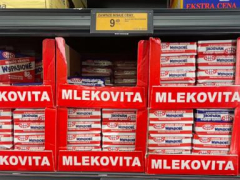PARIS — Pastry chef Arnaud Delmontel rolls out dough for croissants and pain au chocolat that later emerge golden and fragrant from the oven in his Paris patisserie.
The price for the butter so essential to the pastries has shot up in recent months, by 25% since September alone, Delmontel says. But he is refusing to follow some competitors who have started making their croissants with margarine.
“It’s a distortion of what a croissant is,” Delmontel said. “A croissant is made with butter.”
One of life’s little pleasures — butter spread onto warm bread or imbuing cakes and seared meats with its rich flavor — has gotten more expensive across Europe in the last year. After a stretch of post-pandemic inflation that the war in Ukraine worsened, the booming cost of butter is another blow for consumers with holiday treats to bake.
Across the 27-member European Union, the price of butter rose 19% on average from October 2023 to October 2024, including by 49% in Slovakia, and 40% in Germany and the Czech Republic, according to figures provided to The Associated Press by the EU’s executive arm. Reports from individual countries indicate the cost has continued to go up in the months since.
In Germany, a 250-gram (8.8-ounce) block of butter now generally costs between 2.40 and 4 euros ($2.49-$4.15), depending on the brand and quality.
The increase is the result of a global shortage of milk caused by declining production, including in the United States and New Zealand, one of the world’s largest butter exporters, according to economist Mariusz Dziwulski, a food and agricultural market analyst at PKO Bank Polski in Warsaw.
European butter typically has a higher fat content than the butter sold in the United States. It also is sold by weight in standard sizes, so food producers can’t hide price hikes by reducing package sizes, something known as “shrinkflation. ”
A butter shortage in France in the 19th century led to the invention of margarine, but the French remain some of the continent’s heaviest consumers of butter, using the ingredient with abandon in baked goods and sauces.
Butter is so important in Poland that the government keeps a stockpile of it in the country’s strategic reserves, as it does national gas and COVID-19 vaccines. The government announced Tuesday that it was releasing some 1,000 tons of frozen butter to stabilize prices.
The price of butter rose 11.4% between early November and early December in Poland, and 49.2% over the past year to nearly 37 Polish zlotys, or $9 per kilo (2.2 pounds) for the week ending Dec. 8, according to the National Support Center for Agriculture, a government agency.
“Every month butter gets more expensive,” Danuta Osinska, a 77-year-old Polish woman, said while shopping recently at a discount grocery chain in Warsaw.
She and her husband love butter — on bread, in scrambled eggs, in creamy desserts. But they also struggle to pay for medications on their meager pensions. So the couple is eating less butter and more margarine, even though they find the ta





